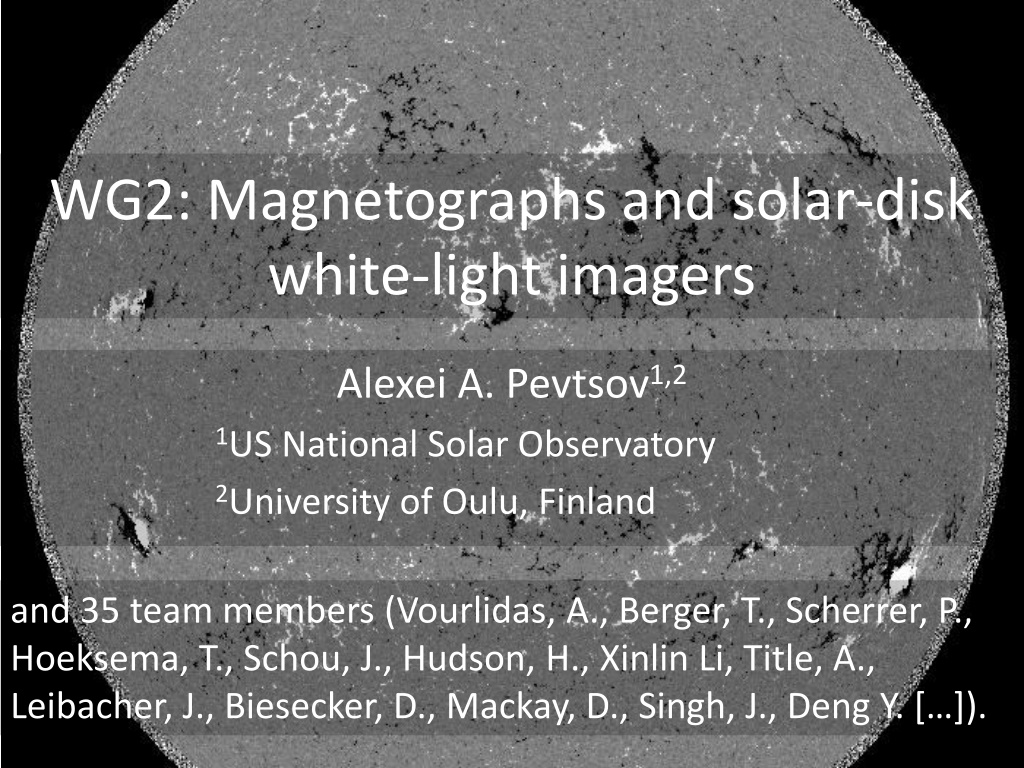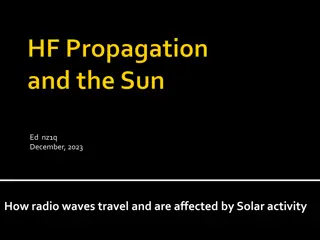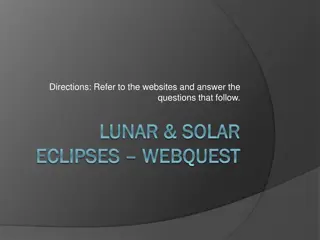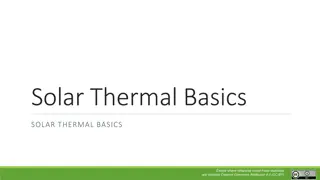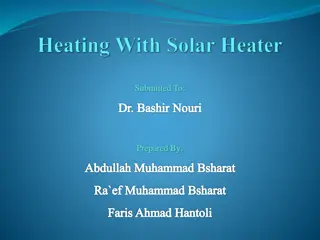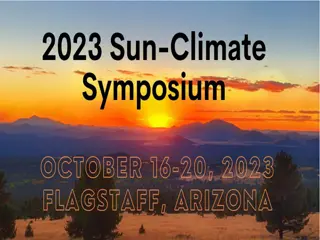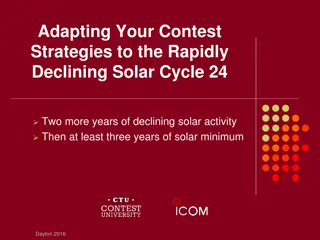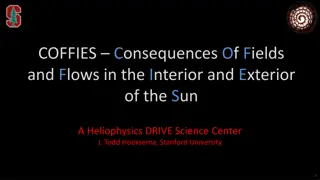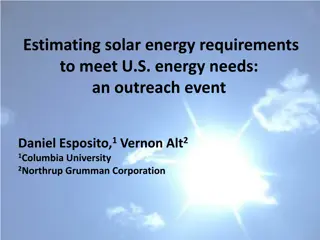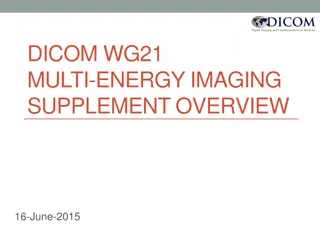Research on Solar Imaging and Magnetography
This research explores advanced solar imaging techniques and magnetographs to enhance space weather forecasting. The study focuses on improving models for solar wind, magnetic field strength, electron density, and temperature. Additionally, it investigates the impact of vector data in modeling solar wind and the importance of synoptic vector maps in global field modeling.
Download Presentation

Please find below an Image/Link to download the presentation.
The content on the website is provided AS IS for your information and personal use only. It may not be sold, licensed, or shared on other websites without obtaining consent from the author.If you encounter any issues during the download, it is possible that the publisher has removed the file from their server.
You are allowed to download the files provided on this website for personal or commercial use, subject to the condition that they are used lawfully. All files are the property of their respective owners.
The content on the website is provided AS IS for your information and personal use only. It may not be sold, licensed, or shared on other websites without obtaining consent from the author.
E N D
Presentation Transcript
WG2: Magnetographs and solar-disk white-light imagers Alexei A. Pevtsov1,2 1US National Solar Observatory 2University of Oulu, Finland and 35 team members (Vourlidas, A., Berger, T., Scherrer, P., Hoeksema, T., Schou, J., Hudson, H., Xinlin Li, Title, A., Leibacher, J., Biesecker, D., Mackay, D., Singh, J., Deng Y. [ ]).
Some Critical Questions Is the L5 magnetograph priority 1 (baseline) or priority 2 (enhanced) payload Objectives of L5 mission (Carrington-type of event? P2; Or improvement of prediction of routine space weather forecast? P1 L5 Objectives (from S. Kraft presentation): [ ] providing improved inputs to SW models [ ] monitoring development of ARs 3-4 days before L1 vantage. LOS or Vector magnetograph?
L5 magnetograph priority 1 (baseline) instrument Data will improve modeling of solar wind (Mackay et al 2016), Pevtsov et at 2016) and the estimates of global quantities: polar flux, total mag. energy, elec. current, open flux, solar wind speed etc. Will provide information on emerging ARs, and allow evaluating their potential for flare/CME eruption. In combination with L1 (and maybe L4?) will provide better representation of global magnetic field topology, polar field, may help with 180-deg. disambiguation of magnetic field.
Effect of L5 data on Modeling of Solar Wind (WSA-Enlil) +L1 Parameter Case 1 Case 2 70-75 km s 1 (20%). 100-120 km s 1 Solar wind speed (30%) 3 cm 3 (40%) 3-4 cm 3 (60-70%) Electron density Magnetic field strength 1 nT (15%) 1 nT (20-25%) Electron temperature 5 KK (10-15%) 15-20 KK (45-50%). Pevtsov et al (2016)
Areas of Open Fields/Coronal Holes L1+L5 Incorrect prediction of CHs Missing CH L1 only Pevtsov et al (2016)
LOS or Vector magnetograph? Current SW forecast uses only LOS, moderate resolution data. Vector data products and their use in SW modeling are not mature enough (recent meeting in Oulu: www.nso.edu/node/1510). Forward looking VMs have potential to significantly improve SW forecast; for mission in 2023, preference is for VM. Should include both Doppler and WL (come with magnetograph data)
Synoptic Vector Maps in NLFFF Global Modeling (SOLIS/VSM) NLFFF global model EIT image EIT image Magnetic free energy Magnetic free energy CR2124 photosphere photosphere Vector maps are necessary for NLFFF extrapolation of coronal fields Magnetic free energy can be used to characterize flare/CME potential of active regions. TFE=11 124 80 Mm above photosphere 80 Mm above photosphere Tadesse et al (2013-2015)
Need Additional Modeling Quantify improvements in SW forecast. Evaluate effects of merging data from different instruments (L1, L5) Polar field improvements Utility for disambiguation, stereo-diagnostics Derivation of vector information from multiple LOS observations. ????
Draft instrument requirements Strong preference for identical instruments at L1 and L5 On board processing Photospheric spectral line (to cross-calibrate with groundbased instruments) Doppler data, white light/continuum (WL imager), also see Kraft et al. (2016) and Vourlidas (2015)
Polar Field from L1-L5-L4 Knowledge of polar fields is critical for many SW models (e.g., PFSS, WSA-Enlil). Combination of L1 and L5 will improve polar field representation.
Helioseismology from L5? Signature of pre-emergence of ARs (SW) Probing deep (dynamo?) layers at the base of the convection zone (new science).
Telemetry, cost, other considerations Tests with SDO/HMI magnetograms with mp4 compression: one 2K by 2K (40 mins) and 256 by 256 (Doppler, 1 min) - 10Kbps. Lev1- onboard, full inversion on the ground Vector - only for strong field areas (ARs). 10-20 Kbps may be a hard requirement to get around. Would require DSN. Drifters (limited instruments) vs. Galactica -class (suite of instruments); multiple back-ups, $100M s/c + (2-3 instr. x $30M) + $70M launcher = $230- 260M
Summary Magnetograph should be a priority 1 (baseline) instrument Strong preferences: Identical instruments on L1 and L5 Vector magnetograph Doppler and WL will come with magnetograph data Helioseismology is enhancement for scientific outcome
Useful articles Kraft, S., Puschmann, K.G., Luntama, J.P., Remore Sensing Optical Instrumentation for Enhanced Space Weather Monitoring from the L1 and L5 Lagrange Points , ICSO, 2016 Mackay, D.H., Yeates, A.R., & Bocquet, F.X. 2016, "Impact of an L5 Magnetograph on Non-potential Solar Global Magnetic Field Modeling , APJ, 825, 131 ,10.3847/0004-637X/825/2/131 Pevtsov, A.A., Bertello, L. , MacNeice, P., and Petrie, G.: 2016, "What if we had a magnetograph at Lagrangian L5?", Space Weather, 14, 1026-1031, DOI: 10.1002/2016SW001471 Vourlidas, A.: 2015, Mission to the Sun-Earth L5 Lagrangian Point: An Optimal Platform for Space Weather Research , Space Weather, 13, 197 201. 10.1002/2015SW001173
